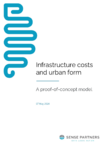Report highlights savings of denser living
The cost benefits of urban intensification have been revealed in a proof-of-concept report commissioned by Greater Wellington.
With the national conversation about urban density, including granny flats, heating up, the ‘Infrastructure costs and urban form’ report prepared by Sense Partners ‘concludes that, overall, density lowers the per-dwelling costs of infrastructure provision.
Regional councillor Thomas Nash says the report should give councils confidence to press on with plans that support compact mixed-use development in and around city centres and connected by high quality public transport.
“Regional growth needs to be smart growth. This report clearly shows that the best bang for our buck is to focus on upgrading existing water, public transport and local roading infrastructure so that we can build better quality, compact residential form, with improved amenities within our cities and towns,” Cr Nash says.
“The further out we go, the further we have to pave roads and lay pipes, and the greater the cost to local councils, the government, ratepayers and taxpayers both now and especially in the future.
As an example, the report calculates the cost of maintaining pipes and roads per dwelling in central Wellington’s Dixon Street, to be seven times cheaper than in Upper Hutt’s Riverstone Terraces.”
The report also notes that the closer residential growth is to a city centre, the more people opt to walk or use other forms of ‘active’ transport, reducing road wear-and-tear and upkeep costs.
“The further we sprawl, the more challenging and costly it becomes to provide attractive and frequent public transport options, giving people little alternative to using their car for every trip.
We can achieve greater value for money for our infrastructure investment by prioritising public transport spending that supports compact, high-amenity urban growth,” Cr Nash says.
The report aims to inform future strategic planning for the region, and supports the Wellington Regional Leadership Committee’s recently adopted Future Development Strategy, which has a strong emphasis on growth within the existing urban footprint.
The Regional Transport Committee, of which Greater Wellington is a member, also recently released the Wellington Regional Transport Emissions Reduction Pathway, which recognises the key role of urban form over the long term in reducing our reliance on private vehicles.
“We are committed to playing a strong role in addressing New Zealand's infrastructure challenges and urgently need to be thinking about how to build smarter. Especially while our ability to pay is increasingly constrained by the rising costs of building for a climate-impacted future,” Cr Nash says.
“Building more compact, mixed-use urban communities will help reduce infrastructure costs, and will make it cheaper and easier to reduce transport emissions, cleaning our air and making our towns and cities healthier.”
The full “Infrastructure costs and urban form” report is available here:
Infrastructure costs and urban form - A proof-of-concept model

This report provides a preliminary analysis of the comparative costs and revenues to local government associated with different types of urban form in the region. The analysis indicates that density… Read more here

date_range Published 29 May 2024
Download now (PDF 1.5 MB) get_appGet in touch
- Phone:
- 0800 496 734
- Email:
- info@gw.govt.nz
